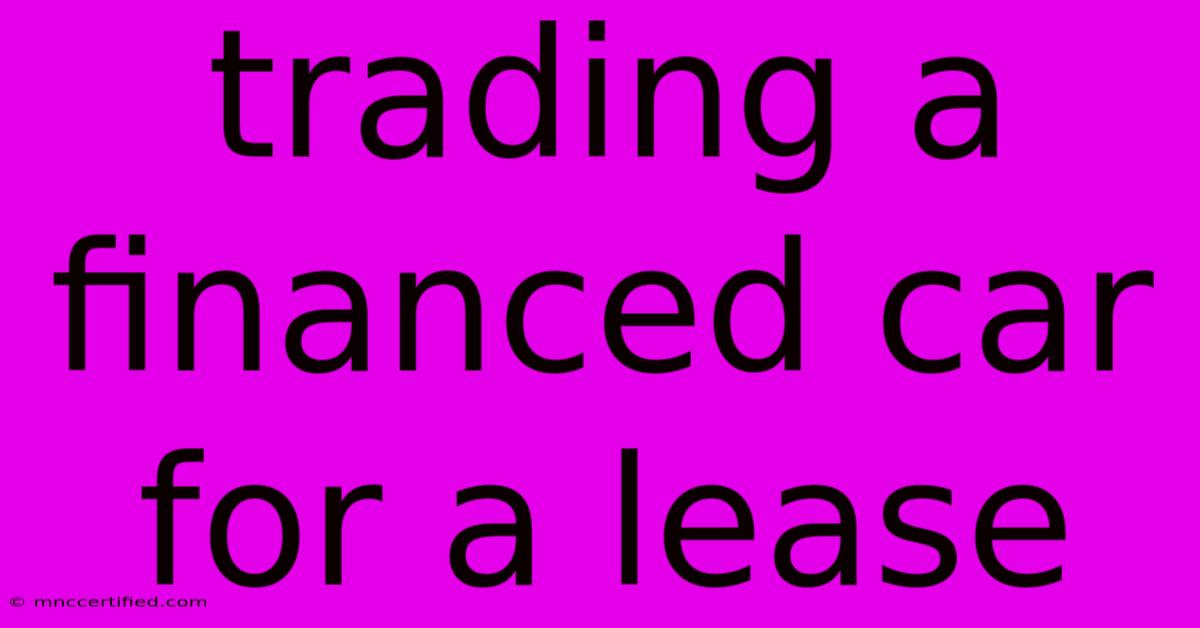Trading A Financed Car For A Lease

Table of Contents
Trading a Financed Car for a Lease: A Smart Move or a Costly Mistake?
Trading in a financed car for a lease might seem like a convenient way to upgrade your vehicle, but it's a decision that requires careful consideration. This comprehensive guide will delve into the financial implications, pros, and cons to help you determine if this strategy aligns with your financial goals.
Understanding Your Current Financial Situation
Before even considering a trade-in, you need a clear picture of your current auto loan. Key factors include:
- Loan Balance: This is the amount you still owe on your current car loan. A higher loan balance will significantly impact your trade-in value and overall cost.
- Interest Rate: A high interest rate means you're paying more in interest over the loan's lifetime. Trading in early may result in a significant penalty, negating any perceived benefits.
- Vehicle's Equity: This is the difference between your car's trade-in value and your loan balance. Positive equity means your car is worth more than you owe; negative equity means you owe more than it's worth. Negative equity is a major hurdle in trading for a lease.
Pro Tip: Obtain a payoff quote from your lender before visiting a dealership. This gives you a clear understanding of your financial position.
The Pros and Cons of Trading a Financed Car for a Lease
Let's weigh the advantages and disadvantages:
Potential Advantages:
- Lower Monthly Payments: Leases often have lower monthly payments than financing, especially for newer, more expensive vehicles. This can free up cash flow for other expenses.
- Driving a New Car: The allure of driving a new car with the latest features and technology is a significant motivator.
- Simplified Maintenance: Leases often come with warranties that cover repairs and maintenance, reducing out-of-pocket expenses.
Significant Disadvantages:
- Negative Equity: As mentioned, this is a major drawback. You'll likely roll the negative equity into the lease, increasing your overall cost significantly. This essentially means you're paying for your old car while leasing a new one.
- Hidden Costs: Leases often come with hidden fees, including disposition fees (paid at lease end), excess mileage charges, and wear-and-tear penalties. These can add up quickly.
- Limited Mileage: Leases have mileage limits. Exceeding these limits can result in substantial charges at the end of the lease term.
- No Ownership: At the end of the lease term, you don't own the vehicle. You'll either need to lease a new car or purchase the vehicle at its residual value, which can be high.
Strategies to Minimize the Risks
- Pay Down Your Loan: If possible, make extra payments to reduce your loan balance and increase your equity. This will significantly improve your trade-in position.
- Negotiate Carefully: Don't hesitate to negotiate the trade-in value and lease terms aggressively. Shop around at different dealerships to compare offers.
- Understand the Lease Agreement: Read the fine print carefully. Pay close attention to mileage limits, wear-and-tear clauses, and all associated fees.
- Consider Refinancing: If you have negative equity, refinancing your existing loan at a lower interest rate might be a better option than trading in for a lease.
When Trading a Financed Car for a Lease Might Make Sense
Trading in a financed car for a lease might be a viable option if:
- You have positive equity: This significantly reduces the financial burden.
- You need a lower monthly payment: Prioritize your financial well-being and ensure the lower payment truly fits your budget.
- You value driving a new car regularly: If you prioritize driving a new car every few years, a lease can be a suitable approach.
Conclusion: Proceed with Caution
Trading a financed car for a lease can be a financially complex decision. Weigh the potential benefits against the significant risks, especially concerning negative equity and hidden fees. Thorough research, careful negotiation, and a clear understanding of your financial situation are crucial before making this important choice. Consider seeking professional financial advice if needed. Remember, a poorly planned trade-in can result in a costly financial burden.

Thank you for visiting our website wich cover about Trading A Financed Car For A Lease. We hope the information provided has been useful to you. Feel free to contact us if you have any questions or need further assistance. See you next time and dont miss to bookmark.
Featured Posts
-
England 20 29 South Africa Rugby Review
Nov 17, 2024
-
Chris Mc Causland Dance Viewers React
Nov 17, 2024
-
Composite Bonding Ruined My Teeth
Nov 17, 2024
-
Rossbacher Insurance North East Pa
Nov 17, 2024
-
Victoria Kjaer Theilvig Miss Universe 2024
Nov 17, 2024